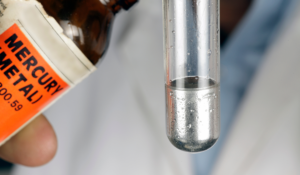Every business tries to find ways to cut costs. But, no matter what route you take, denying workers proper safety protection is never an option.
Eventually, workers become sick, operational man-hours are affected, and production becomes hampered. Even worse, your business can end up receiving huge fines, while your workers can become critically sick, and even die.
Mercury is exactly the sort of substance that should be handled with caution at any worksite.
Mercury a naturally occurring metal which exists in three basic forms:
- Elemental /metallic.
- Inorganic compound, when it combines with other elements [e.g. chlorine, sulfur, and oxygen].
- Organic compound, when it combines with carbon or carbon-containing substances.
Mercury exposure occurs mostly during mining, production, and transportation of mercury, as well as mining and refining of gold and silver ores. In industry, it’s often found in thermometers, manometers, barometers, gauges, valves, switches, batteries, and high-intensity discharge (HID) lamps.
Now, following an investigation of one Long Island plant, mercury exposure & lack of safety equipment has resulted in 21 OSHA violations and fines totaling more than $195K.
Let’s find out what went wrong, and how this could have been avoided.
Related Article: Mercury Poisoning Leads to OSHA Investigation and Fines

What Happened?
Following the sickening of several workers at the Long Island thermometer plant, an OSHA investigation led to 21 violations, as a result of overexposing employees to mercury at its West Babylon facility.
The investigation revealed that the company overexposed employees to airborne elemental mercury in August 2022, while they worked to distill and purify elemental mercury, fill thermometers, blow glass, and during calibration & engraving of thermometers and hydrometers.
Federal inspectors found the company willfully exposed and severely sickened workers by allowing the airborne concentration of the toxic metal to exceed the 8-hour; time-weighted average based on biological exposure indices.
High levels of mercury exposure could result in permanent nervous system or kidney damage.
Related Article: Heavy Metal Testing Should Not be Taken Lightly
OSHA inspectors identified the following: 18 serious violations, 1 willful violation, and 2 other-than-serious violations.
To break it down in detail, the company failed to provide the following safety measures:
- Engineering controls to reduce mercury exposure.
- Complete and effective respiratory protection and chemical hazard communication programs.
- Appropriate personal protective equipment and clothing.
- An emergency response plan to handle cleanup of spilled mercury.
- Eating and food storage areas free of mercury exposure.
- An emergency shower and appropriate first aid.
- Proper labeling for all hazardous chemical containers.
- Recording of all recordable work-related injuries and illnesses.
- Report a work-related incident resulting in in-patient hospitalization due to mercury poisoning.
As a result of the mercury exposure & ill workers, a fine of $195,988 has been proposed. Now, the company has 15 business days from receipt of its citations and penalties to comply, request an informal conference with OSHA’s area director or contest the findings before the independent Occupational Safety and Health Review Commission.
Respiratory Protection for Your Workers
Respiratory protection in the workplace is of utmost importance, for both you and your team.
Compliance with the OSHA Respiratory Protection Standard could prevent hundreds of deaths, and thousands of illnesses annually.
Here’s a quick breakdown what you’ll need to keep in mind when following OSHA’s extensive guidelines for respirator use in the workplace:
- Medical evaluations of CSHOs required to use respirators;
- Fit testing procedures for tight-fitting respirators;
- Use of respirators in routine and reasonably foreseeable emergency escape situations;
- Procedures and schedules for cleaning, disinfecting, storing, inspecting, repairing, and otherwise maintaining respirators;
- Procedures to ensure adequate air quality, quantity and flow of breathing air for self-contained breathing apparatus (SCBA);
- Training employees in the respiratory hazards to which they are potentially exposed;
- Training employees in the proper use of respirators, including putting on and removing them, any limitations on their use, and maintenance procedures; and
- Procedures for regularly evaluating the effectiveness of your program
Read more on OSHA’s standard on Mercury.
Bringing It Together
Mercury exposure is a serious case. When workers are properly protected and worksites kept safe, government agencies, employers, and employees remain happy and business runs smoothly.
Keeping safe and following OSHA guidelines may seem costly in the short-term, but in the long-run, it’s the best option for everyone.
Whether your team works with mercury on the jobsite, or any number of dangerous substances, keeping them protected is of the utmost importance.
Protect your workers, keep your worksite safe, and both your business & team will reap the rewards.
***
About Worksite Medical
In most cases, OSHA requires medical surveillance testing, and at no cost to employees.
Worksite Medical makes that program easier with mobile medical testing.
We conduct on-site respirator fit tests, as well as audiometric exams, pulmonary function tests and heavy metal lab work, right on your job site. We also keep accurate, easy-to-access medical records for your convenience. You’ll keep your employees at work, and stay ahead of OSHA inspections.




